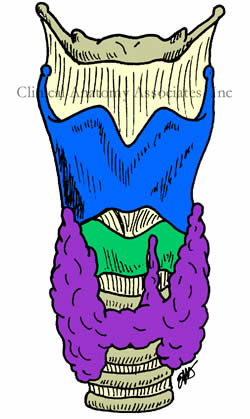The term [larynx] originates from the Greek [λάρυγξ] meaning "upper windpipe or throat". Known vernacularly as "Adam's apple" or the "voice box" (not proper clinical terms), the larynx is the organ of phonation, and one of the organs found in the cervical visceral compartment. It is found immediately superior to the trachea, and anterior to the pharynx and esophagus.
It is formed by nine cartilages, three of which are median and single (epiglottis, thyroid, and cricoid cartilages), the rest being paired (arytenoid, corniculate, and cuneiform cartilages). In the accompanying image, the thyroid cartilage is depicted in blue, and the cricoid cartilage in green.
Within the larynx is a pair of musculomembranous folds, the vocal cords, which are innervated by the recurrent laryngeal nerves, branches of the Xth cranial nerve, also known as the vagus nerve.
The thyroid gland (in purple) is related to the inferior aspect of the larynx. The gland receives its name from the thyroid cartilage of the larynx, as the Greek term [θυροειδής] (thyreoeidís) means "in the shape of an oblong-shield".
It was Andrea Vesalius who named the cricoid cartilage because of its shape. The Greek term [κρικοειδή] (krikoeidí) refers to a structure "shaped like a ring". The cricoid cartilage is a complete ring, and thus is different from the incomplete or "C" shaped rings of the trachea.
Image property of CAA Inc. Artist: Dr. Miranda




